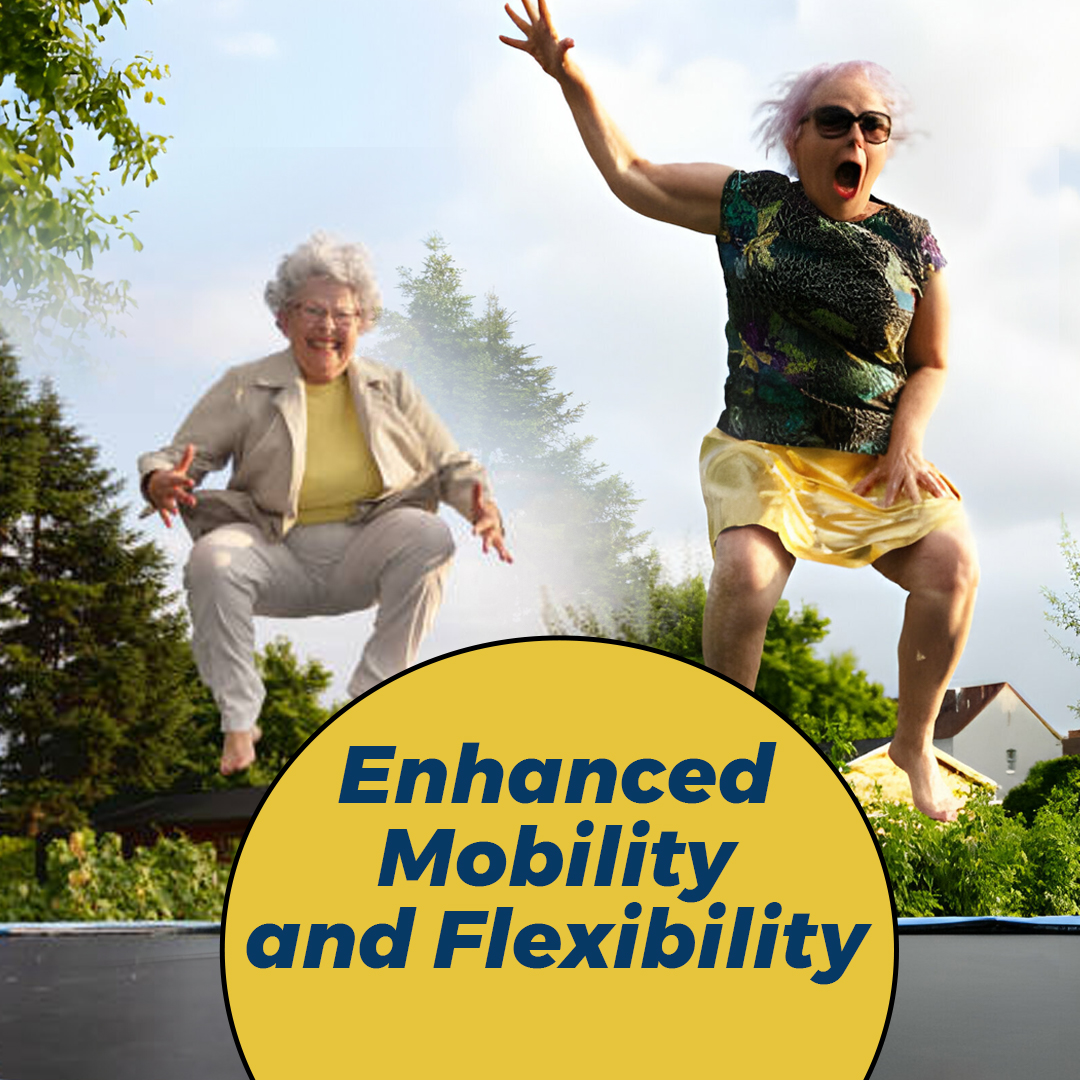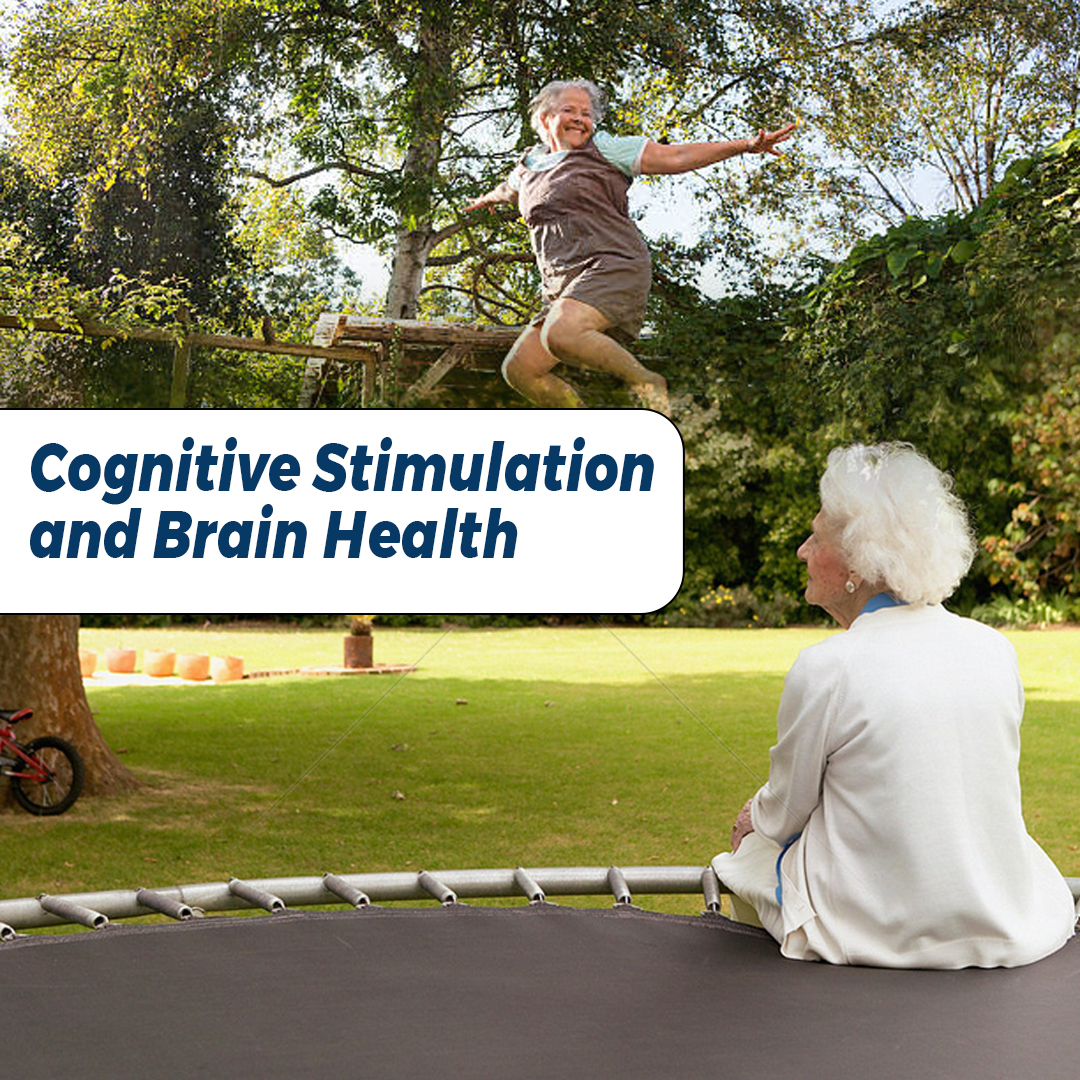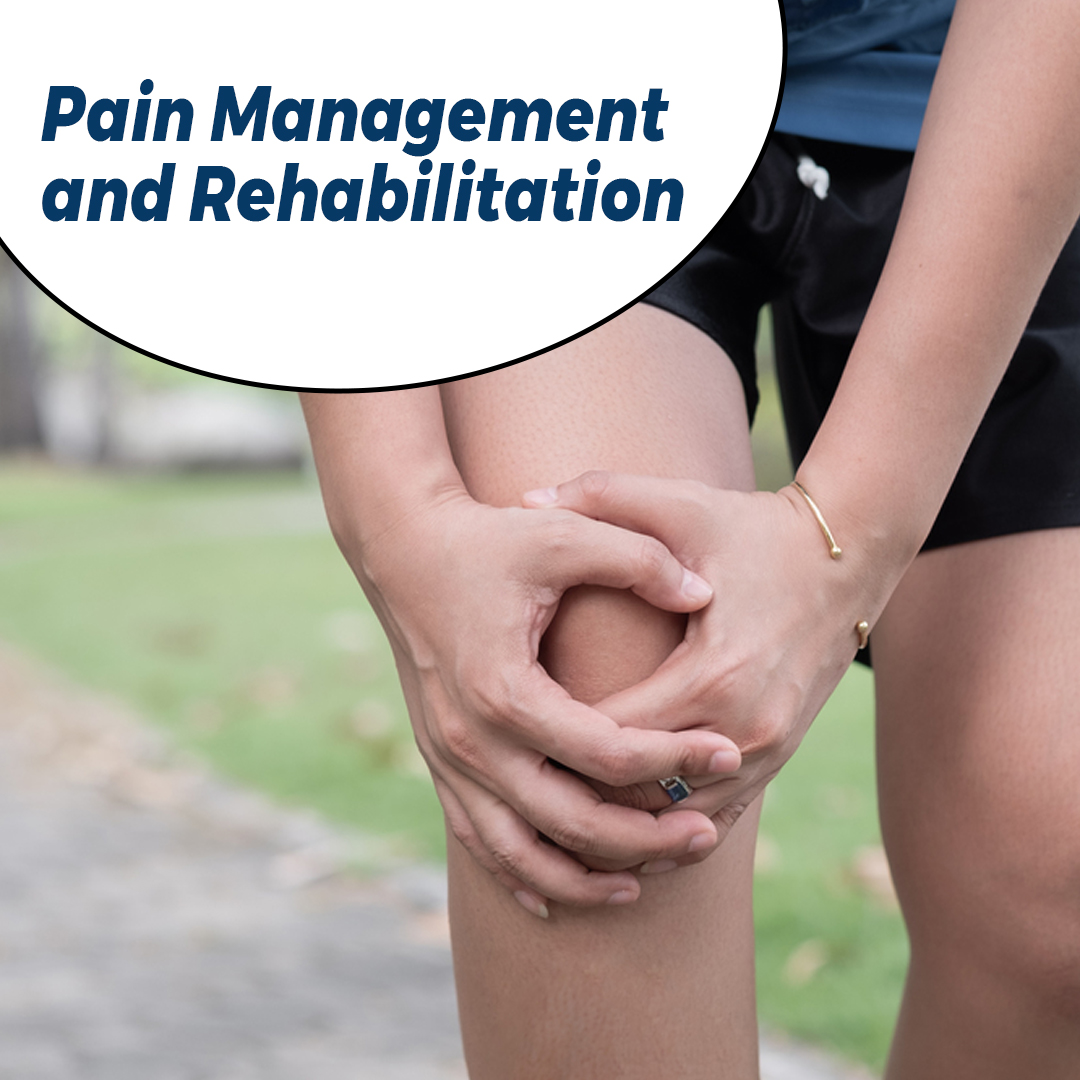
Table of Contents
ToggleTrampolining has become popular with people of all ages recently, and seniors are jumping on the bandwagon. Studies show trampolining, or rebounding, has significant benefits for older adults, both physical and mental.
As we age, balance and coordination naturally decline. Trampolining helps combat this by strengthening core muscles and improving proprioception, your body’s ability to sense movement and position. Even just bouncing gently on a garden trampoline a few times a week can make a big difference.
Trampolining provides an effective cardio workout with minimal stress on joints. The trampoline absorbs up to 80% of the shock, reducing strain on knees, hips and ankles. This makes it ideal for older adults and those with mobility issues. Trampolining also releases feel-good hormones called endorphins that improve your mood and act as natural painkillers.
In this blog, we will be discussing such surprising benefits of trampolining for seniors in detail.
Enhanced Mobility and Flexibility

Once you start bouncing, you’ll immediately feel the effects on your joints and muscles. The low-impact, gravity-reduced environment takes pressure off your joints, allowing you to move freely without pain. Regular bouncing helps lubricate joints and strengthen surrounding muscles, improving range of motion and flexibility over time. To enhance your experience make sure you maintain your garden trampoline properly.
Basic bounces: Simple up and down bounces are easy on the joints but provide motion and impact. Start with small bounces and build up as you get more comfortable.
Knee lifts: Lift one knee at a time up towards your chest as you bounce. For added challenge, try criss crossing your knees.
Heel touches: As you bounce, touch your left heel with your right hand, then your right heel with your left hand. Twist from your waist to reach, keeping your back straight. This movement helps loosen tight hips and spine.
Seated bounces: If standing bounces are too difficult, try sitting on the edge of the garden trampoline and bouncing from a seated position. This still provides motion but with even less impact. Use the handlebars for support and bounce as high as is comfortable for you.
Cognitive Stimulation and Brain Health

Trampolining requires a great deal of focus and concentration to perform the jumps and landings safely. This focused attention provides cognitive exercise for seniors that can strengthen neural connections in the brain responsible for attention and concentration. Studies show that activities requiring hand-eye coordination and balance can boost cognition and mental sharpness in older adults.
Enhanced Coordination
The act of jumping, bouncing and balancing on a garden trampoline calls upon multiple areas of the brain responsible for motor skills and coordination. For seniors, practising and improving coordination through trampolining provides mental exercise that can maintain and even enhance cognitive abilities. The repetitive yet engaging nature of trampolining has been shown to stimulate the release of neurotransmitters in the brain that support neural health and connectivity.
Stress Reduction
Trampolining is an enjoyable activity for many seniors that leads to feelings of joy and excitement. Exercise that elevates mood and reduces stress has been shown to have a protective effect on the brain. Trampolining may help combat symptoms of anxiety and depression in seniors by releasing feel-good hormones called endorphins. Reduced stress and improved mood support overall brain health and cognition.
The cognitive, coordination and mood benefits of trampolining make it an activity worth trying for seniors looking to maintain mental sharpness and vitality as they age. Under the guidance of a trained instructor, trampolining provides an opportunity for safe risk-taking through measures like safety enclosure net and trampoline padding while learning new skills that stimulate the brain.
Pain Management and Rehabilitation

Trampolining provides a low-impact form of exercise that can help relieve chronic pain from conditions like arthritis or fibromyalgia. The gentle bouncing motion helps loosen joints and muscles without putting excess strain on the body. Trampoline socks are always recommended whenever you are using a trampoline, to help you with the grip which is important to prevent slips while jumping. Regular trampolining can increase mobility, flexibility and range of motion. The activity also releases endorphins which act as natural painkillers in the body and improve your mood.
Recovering from Injury
If you’re recovering from an injury or surgery, trampolining can be an excellent form of rehab exercise. The low-impact bouncing helps improve balance, coordination and strength. It increases blood flow to aid healing and gently works your muscles and joints. Always check with your doctor before trampolining if recovering from an injury. Start slowly and be very cautious, avoiding any moves that cause discomfort.
Reduced Inflammation
The lymph system helps remove waste and fluid from tissues in your body. Trampolining helps stimulate the lymph system, improving drainage and reducing inflammation. This can help relieve pressure, pain and discomfort. The activity also boosts circulation, transporting oxygen and nutrients throughout the body while removing toxins. Improved circulation speeds healing and provides pain relief.
While trampolining does provide benefits for pain and rehab, you must proceed slowly and carefully, especially if new to the activity or recovering from an injury. Always listen to your body and avoid any moves that cause discomfort. With regular practice, trampolining can become an enjoyable part of your exercise routine and an effective way to manage chronic pain or recover from injuries. The benefits to both your physical and mental wellbeing make it worth bouncing into.
Social Connection and Emotional Well-being

Trampolining isn’t just about physical activity; it’s also an opportunity for seniors to connect with others and boost their emotional well-being.
Community Engagement
Participating in trampolining sessions provides seniors with a chance to interact with like-minded individuals in a supportive and inclusive environment. Sharing the experience of bouncing on a garden trampoline can foster a sense of camaraderie and belonging among participants, creating a tight-knit community of seniors who share a passion for staying active and having fun.
Building Relationships
Whether it’s striking up a conversation between jumps or cheering each other on during group exercises, trampolining offers ample opportunities for seniors to forge new friendships and strengthen existing bonds. These social connections can enhance seniors’ overall sense of happiness and fulfilment, combating feelings of loneliness and isolation often associated with ageing.
Emotional Support
Garden trampoline sessions provide seniors with a safe space to express themselves freely and release pent-up emotions. The exhilarating sensation of bouncing can be a natural mood booster, helping seniors alleviate stress, anxiety, and feelings of depression. Additionally, the encouragement and support received from fellow trampoline enthusiasts can provide an emotional lift, empowering seniors to overcome challenges and embrace life with renewed vigour.
Sense of Belonging
For many seniors, trampolining isn’t just a form of exercise—it’s a way of belonging to a community that shares their interests and values. Whether they’re attending regular garden trampoline classes or participating in special events and workshops, seniors who engage in trampolining often find a sense of belonging and acceptance that enriches their lives and enhances their overall well-being.
Balance and Fall Prevention

Seniors are often at risk of falls due to factors such as reduced muscle strength, impaired balance, and changes in gait. Trampolining can be an effective tool for improving balance and reducing the risk of falls among older adults.
Strengthening Core Muscles
Trampolining engages the core muscles, including the abdominals, obliques, and lower back, which are essential for maintaining balance and stability. As seniors bounce on the garden trampoline, these muscles are activated to help stabilise the body, improving overall balance and reducing the likelihood of falls.
Enhancing Proprioception
Trampolining requires seniors to constantly adjust their body position and respond to changes in surface support, which helps enhance proprioception—the body’s awareness of its position in space. By challenging proprioceptive abilities, trampolining can improve seniors’ balance and coordination, reducing the risk of falls.
Promoting Confidence
As seniors gain strength, coordination, and balance through trampolining, they often experience a boost in confidence in their ability to navigate their surroundings safely. This increased confidence can empower seniors to remain active and independent, reducing their fear of falling and enhancing their quality of life.
Supervised Training
While trampolining offers numerous benefits for balance and fall prevention, it’s essential for seniors to engage in supervised training sessions, especially when first starting out or when performing more advanced exercises. A qualified instructor can provide guidance on proper technique, monitor for any signs of fatigue or discomfort, and ensure a safe and enjoyable experience for all participants.
Conclusion
In summary, trampolining on a garden trampoline has lots of good things for older people, like helping their bodies and minds feel better. It’s good for moving and thinking better, managing pain, and feeling happier. Trampolining is easy on the body, so even seniors with joint issues can do it. It can help them move better and feel less pain. Plus, it’s fun and can make them feel good emotionally too.
But, they need to be careful and have someone watch them when they start. Trampolining can be risky, especially if they’re not used to it or if they have health problems. Overall, trampolining can be a great way for seniors to stay healthy, happy, and connected with others. As long as they take it slow and stay safe, bouncing on a garden trampoline could bring a lot of joy and benefits into their lives.
FAQ's
Yes, trampolining offers a low-impact form of exercise that can help relieve chronic pain from conditions like arthritis or fibromyalgia. The gentle bouncing motion helps loosen joints and muscles without excessive strain, while also releasing endorphins that act as natural painkillers and improve mood.
Trampolining engages core muscles and challenges proprioceptive abilities, which are essential for maintaining balance and stability. Regular practice can enhance seniors’ balance, coordination, and confidence in navigating their surroundings safely, reducing the risk of falls.
Seniors should engage in supervised training sessions, especially when starting out or performing more advanced exercises. A qualified instructor can provide guidance on proper technique, monitor for signs of fatigue or discomfort, and ensure a safe and enjoyable experience for all participants.
Jumping on a trampoline can potentially benefit individuals with osteoporosis by promoting bone density through weight-bearing exercise.
Trampolining can be a fun and effective form of exercise for older people, as it provides a low-impact cardiovascular workout that improves balance, coordination, and muscle strength.




